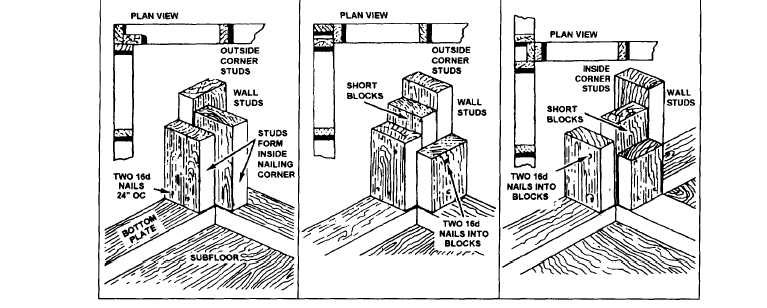Figure 1-34.—Corner posts.
for example, require heavier structural lumber. This
requirement is specific to the lower levels in order to
support the weight of the floors above.
STRUCTURAL PARTS
A wood-framed wall consists of structural parts
referred to as “wall components” or “framing
members.” The components (shown in fig. 1-33)
typically include studs, plates, headers, trimmers,
cripples, sills, corner posts, and diagonal braces. Each
component is essential to the integrity of the total wall
structure.
Studs
Studs are upright (vertical) framing members
running between the top and bottom plates. Studs are
usually spaced 16 inches OC, but job specifications
sometimes call for 12-inch and 24-inch OC stud
spacing.
Plates
The plate at the bottom of a wall is the soleplate, or
bottom plate. The plate at the top of the wall is the top
plate. A double top plate is normally used. It strengthens
the upper section of the wall and helps carry the weight
of the joists and roof rafters. Since top and bottom plates
are nailed into all the vertical wall members, they serve
to tie the entire wall together.
Corner Posts
Corner posts are constructed wherever a wall ties
into another wall. Outside comers are at the ends of a
wall. Inside corners occur where a partition ties into a
wall at some point between the ends of the wall.
Three typical designs for corner assemblies are
shown in figure 1-34. View A shows outside corner
construction using only three studs. View B shows
outside corner construction using two studs with short
blocks between them at the center and ends. A third
full-length stud can be used instead of blocks. View C
shows inside corner construction using a block laid flat.
A full-length stud can be used instead of a block. Note
that all corner assemblies should be constructed from
straight stud material and should be well nailed. When
framing corners, you can use full-length studs or short
blocks.
Rough Door and Window Openings
A rough opening must be framed into a wall
wherever a door or window is planned. The dimensions
of the rough opening must allow for the final frame and
for the required clearance around the frame.
Figure 1-35 shows details of rough openings for
doors and windows in wood-frame construction. The
rough opening for atypical door is framed with a header,
1-18

